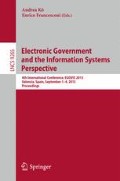Abstract
Biometric identification technologies have become very popular in the last ten years. Applications that use biometrics are multiple and can be used for a variety of purposes: from physical access control, to authentication and access to information, recognition of people, etc. E-government is certainly a context where biometrics has a crucial role, because high level of assurance about the identity of citizens is required, whenever they interact by means of digital procedures with the Public Sector. Advanced technologies of digital identity may be seen as a factor influencing the quality improvement and raising the availability of services that require trusted environment.
This paper is aimed to find promising methods and models of building infrastructure of public and commercial services in the field of biometrics identification. Two practical cases (Russian and Italian) have been taken for the analysis in this regards. The authors are focused on modern technological trends in ICT- distribution of biometric technologies and mobile applications in the field of e-government and prepared conclusions on its best implementation not just in two studied countries but worldwide as well.
Access this chapter
Tax calculation will be finalised at checkout
Purchases are for personal use only
References
Bailador, G., Sanchez-Avila, C., Guerra-Casanova, J., Sierra, A.: Analysis of pattern recognition techniques for in-air signature biometrics. Pattern Recogn. 44(10–11), 2468–2478 (2011)
Bastys, A., Kranauskas, J., Krüger, V.: Iris recognition by fusing different representations of multi-scale Taylor expansion. Comput. Vis. Image Underst. 115(6), 804–816 (2011)
Bowyer, K.W., Hollingsworth, K., Flynn, P.J.: Image understanding for iris biometrics: a survey. Comput. Vis. Image Underst. 110(2), 281–307 (2008)
Tan, T., Zhang, X., Sun, Z., Zhang, H.: Noisy iris image matching by using multiple cues. Pattern Recogn. Lett. 33(8), 970–977 (2012)
Chen, C., Veldhuis, R.: Extracting biometric binary strings with minimal area under the FRR curve for the hamming distance classifier. Sig. Process. 91(4), 906–918 (2011)
Chin, Y.J., Ong, T.S., Teoh, A.B.J., Goh, K.O.M.: Integrated biometrics template protection technique based on fingerprint and palmprint feature-level fusion. Inf. Fusion 18, 161–174 (2014)
Crawford, H., Renaud, K., Storer, T.: A framework for continuous transparent mobile device authentication. Comput. Secur. 39(B), 127–136 (2013)
Karnan, M., Akila, M., Krishnaraj, N.: Biometric personal authentication using keystroke dynamics: a review. Appl. Soft Comput. 11(2), 1565–1573 (2011)
Eskander, G.S., Sabourin, R., Granger, E.: A bio-cryptographic system based on offline signature images. Inf. Sci. 259, 170–191 (2014)
McDuff, D., El Kaliouby, L., Senechal, T., Demirdjian, D., Picard, R.: Automatic measurement of ad preferences from facial responses gathered over the Internet. Image Vis. Comput. 32(10), 630–640 (2014)
Rathgeb, C., Busch, C.: Cancelable multi-biometrics: Mixing iris-codes based on adaptive bloom filters. Comput. Secur. 42, 1–12 (2014)
Economic 360 for Egypt: Growth Prospects and Emerging Opportunities in the Healthcare Industry (2011). https://frost.com/prod/servlet/report-brochure.pag?id=4721-01-00-00-00
Public Health: Improving health for all EU citizens (2013). http://ec.europa.eu/health/health_policies/docs/improving_health_for_all_eu_citizens_en.pdf
Patient Safety and Quality of Care. Special Euro barometer 411 (2013). http://ec.europa.eu/public_opinion/archives/ebs/ebs_411_en.pdf
Market Statistics 2012. Biometric Technology Today, 16(6), 12 (2008). doi:10.1016/S0969-4765(08)70168-1
Federal Law of the Russian Federation “On personal data №152 from 21.07.2014, art.11, p. 2 (2014)
Gamassi, M., Lazzaroni, M., Misino, M., Piuri, V., Sana, D., Scotti, F.: Acccuracy and performance of biometric systems. In: Proceedings of MTC 2004 – Instrumentation and Measurement Technology Conference (2014). http://crema.di.unimi.it/~fscotti/ita/pdf/Scotti14.pdf
Privacy Guarantor General Act about Biometry November, 2014. Published in “Gazzetta Ufficiale” n. 280, 2 December 2014
Article 29 Working Party, European Commission, Directive 95/46/EC of the European Parliament and of the Council of 24 October 1995 (1995)
Electronic identification and trust services (eIDAS): regulatory environment and beyond. Digital Agenda for Europe. European Commission Directorate General (2015). http://ec.europa.eu/dgs/connect/en/content/electronic-identification-and-trust-services-eidas-regulatory-environment-and-beyond
Matveev, Y.N.: Biometric technologies of person identification by voice and other modalities, Vestnik MGTU. Priborostroenie. Biometric Technol. Special Issue 3(3), 46–61 (2012)
Gorelik, S., Lyaper, V., Bershadskaya, L., Buccafurri, F.: Breaking the barriers of e-participation: the experience of russian digital office development. In: Kȍ, A., Francesconi, E. (eds.) EGOVIS 2014. LNCS, vol. 8650, pp. 173–186. Springer, Heidelberg (2014)
Acknowledgments
This work was partially financially supported by research work No.415825 “Development of opinion-mining tool for getting citizens’assessment on government activities”.
Author information
Authors and Affiliations
Corresponding author
Editor information
Editors and Affiliations
Rights and permissions
Copyright information
© 2015 Springer International Publishing Switzerland
About this paper
Cite this paper
Kachurina, P., Buccafurri, F., Bershadskaya (Vidiasova), L., Bershadskaya, E., Trutnev, D. (2015). Biometric Identification in eHealthcare: Learning from the Cases of Russia and Italy. In: Kő, A., Francesconi, E. (eds) Electronic Government and the Information Systems Perspective. EGOVIS 2015. Lecture Notes in Computer Science, vol 9265. Springer, Cham. https://doi.org/10.1007/978-3-319-22389-6_8
Download citation
DOI: https://doi.org/10.1007/978-3-319-22389-6_8
Publisher Name: Springer, Cham
Print ISBN: 978-3-319-22388-9
Online ISBN: 978-3-319-22389-6
eBook Packages: Computer ScienceComputer Science (R0)

